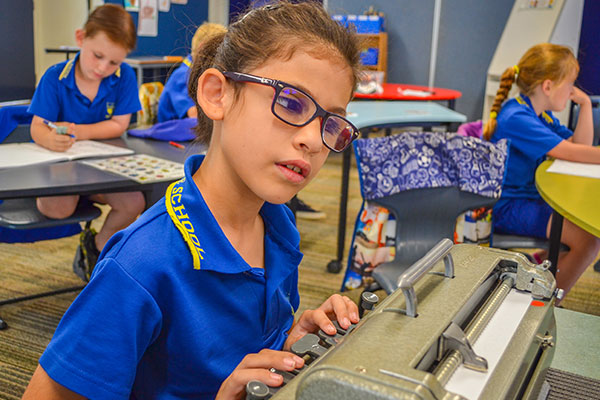
All Queensland state schools make
reasonable adjustments to enable children of all abilities to attend school, participate in school activities and access the curriculum.
To support students with vision impairment, schools are able to access a range of supports and services tailored to meet their individual needs.
Supports at school
Every student with vision impairment has different needs and will need different reasonable adjustments to attend school and access, participate and engage in the curriculum and in school activities.
State schools consult parents about the reasonable adjustments that may be made. Students are also consulted as much as possible, depending on their age and individual circumstances.
Reasonable adjustments are identified based on the student's individual needs and may include adjustments to learning activities, teaching strategies, assessment, communication, use of assistive technology or changes to the learning environment. The student may also need adjustments to support them to engage with peers and to stay healthy and safe. Schools determine the best way to record the individual supports being provided to students at their school.
Reasonable adjustments specific to vision impairment may include the use of Braille, visual markers in the school environment and providing resources in larger print.
For more information about common types of reasonable adjustments, refer to the
general information for students with disability page.
If you have any questions regarding the supports and reasonable adjustments being provided for your child or how these are documented, please talk to your child’s classroom teacher or principal.
Resources and support services available to schools
Schools are able to access a range of resources and support services to assist them to make reasonable adjustments. Please contact your child’s school to discuss your child’s specific needs.
Resources
- The
blindness and vision impairment toolkit supports students with vision impairments in the classroom. The toolkit, developed by Statewide Vision Impairment Services (SVIS), provides teachers and schools with high-quality resources as a first point of reference to support students with vision impairments. In conjunction with expert support and advice from advisory visiting teachers (AVTs), this toolkit will enhance capability and understanding of teachers. The online toolkit comprises 3 modules.
- The understanding blindness and vision impairment module defines and outlines blindness and vision impairment, factors influencing vision acuity and its impact.
- The supporting students module outlines the key policies regarding disability. It provides guidance for reporting requirements and implementing assistive technologies for educational adjustments. It also outlines school-based strategies for curriculum and extra-curricular activities (including incursions and excursions).
- The eye conditions and educational implications module outlines key eye conditions in more detail, including attributes associated with each eye condition and implications for students and the school. It also outlines reasonable adjustments for schools to implement and how to support students with specific eye conditions.
-
Queensland Braille Learning Progression and assessment tool
-
Braille letter songs
-
Braille contractions songs
-
I can do Braille
-
Hands on literacy
Support services
Schools can access a range of specialist advice to help them make reasonable adjustments including the following.
Schools are responsible for accessing these supports and resources and may need your consent to access these support services. More information about resources is available at
general information for students with disability.
More information about how students can be supported at school can be found on the
Nationally Consistent Collection of Data on School Students with Disability website.